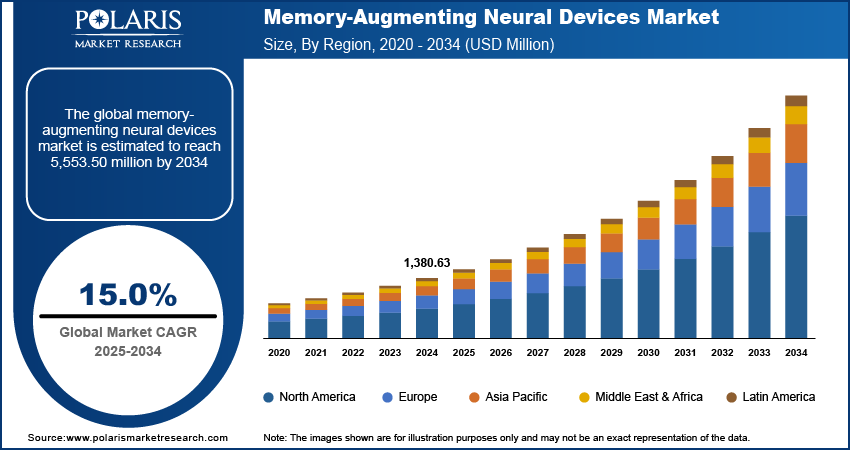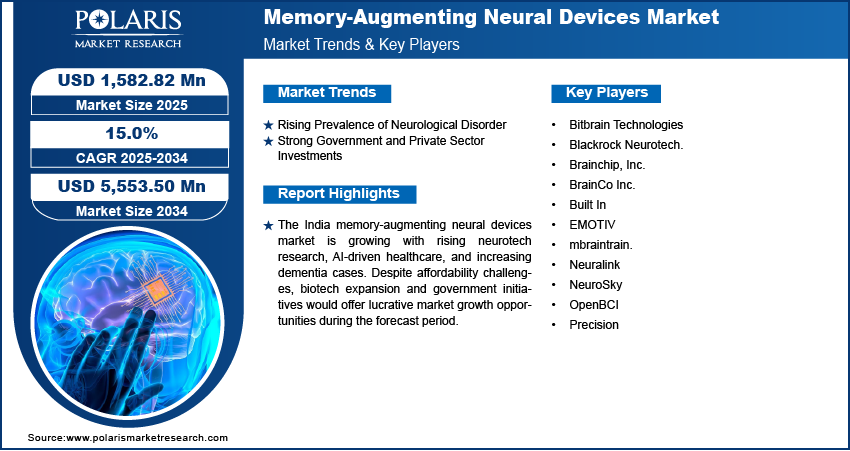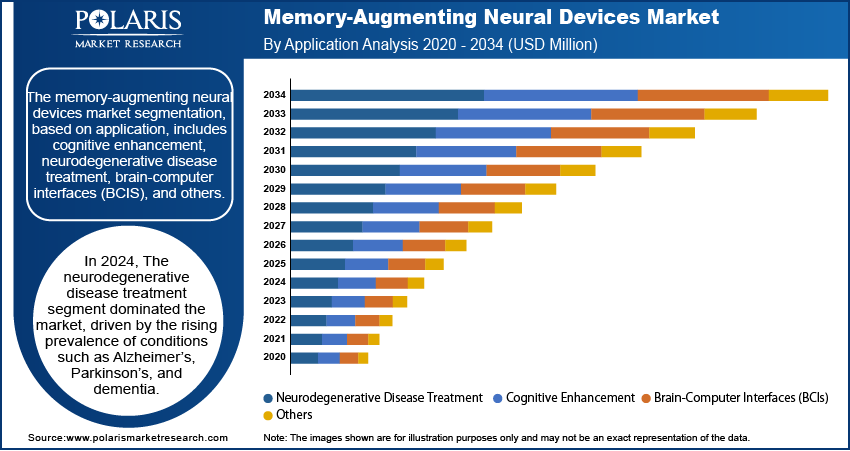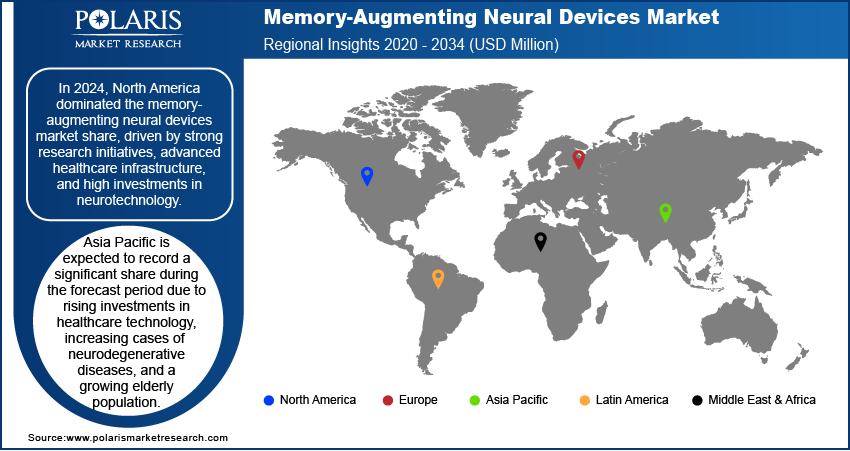
Memory-Augmenting Neural Devices Market Size, Share, Trends, Industry Analysis Report: By Device Type (Implantable Neural Devices, Noninvasive Brain Stimulation Devices, and Others), Technology, Application, End User, and Region (North America, Europe, Asia Pacific, Latin America, and Middle East & Africa) – Market Forecast, 2025–2034
- Published Date:Apr-2025
- Pages: 125
- Format: PDF
- Report ID: PM5455
- Base Year: 2024
- Historical Data: 2020-2023
Memory-Augmenting Neural Devices Market Overview
The global memory-augmenting neural devices market size was valued at USD 1,380.63 million in 2024. The market is projected to grow from USD 1,582.82 million in 2025 to USD 5,553.50 million by 2034, exhibiting a CAGR of 15.0% during 2025–2034.
Memory-augmenting neural devices combine neural networks with external memory components to enhance their ability to store and retrieve information, improving performance in tasks requiring reasoning and learning from past experiences. These devices are used in AI applications to support more efficient and flexible decision making by integrating long-term memory capabilities.
The rapid progress in neuroscience and brain-computer interfaces is driving the memory-augmenting neural devices market growth. Researchers better understand how the brain stores and processes memories, enabling the development of advanced neural implants. Scientists can create devices that enhance memory retention and recall with advanced technologies such as AI, machine learning, and neurostimulation. These innovations benefit individuals with memory-related disorders and open possibilities for cognitive enhancement in healthy individuals, thereby driving the market development.

To Understand More About this Research: Request a Free Sample Report
Artificial intelligence (AI) and machine learning (ML) are playing a crucial role in improving neural implants. AI-driven algorithms analyze brain signals in real time, optimizing memory restoration and enhancement processes. These smart technologies help personalize treatments based on an individual’s brain activity, leading to better outcomes. AI also enables predictive analytics, allowing doctors to anticipate memory decline and intervene early. The integration of AI is transforming memory-augmenting devices into more efficient and user-friendly solutions, thereby driving the memory-augmenting neural devices market demand.
Memory-Augmenting Neural Devices Market Dynamics
Rising Prevalence of Neurological Disorders
Memory disorders such as Alzheimer’s disease, dementia, and Parkinson’s disease are becoming more common, especially among aging populations. According to Alzheimer’s Disease International, in 2020, 55 million people were affected by Alzheimer’s Disease, showcasing growth in Alzheimer’s disease cases. Traditional treatments offer limited effectiveness, creating a strong demand for innovative memory-restoring solutions. Memory-augmenting neural devices present a promising alternative by helping individuals regain lost cognitive functions. Additionally, governments and healthcare organizations are investing in research and development as the number of people affected by neurodegenerative conditions rises globally, thereby driving the growth of the memory-augmenting neural device market revenue.
Strong Government and Private Sector Investments
Governments and private investors are recognizing the potential of neurotechnology and are funding research initiatives focused on brain implants. Programs such as the US Brain Initiative and Europe’s Human Brain Project are accelerating developments in this field. Additionally, tech giants and venture capitalists are backing neurotech startups, leading to rapid commercialization. These investments support innovation, improve manufacturing processes, and reduce costs, making memory-augmenting neural devices more accessible, thereby driving the memory-augmenting neural devices market expansion.

Memory-Augmenting Neural Devices Market Segment Analysis
Memory-Augmenting Neural Devices Market Assessment by Device Type Outlook
The memory-augmenting neural devices market segmentation, based on device type, includes implantable neural devices, noninvasive brain stimulation devices, and others. The noninvasive brain stimulation devices segment is expected to witness significant growth during the forecast period. Technologies such as transcranial magnetic stimulation (TMS) and transcranial direct current stimulation (tDCS) are gaining popularity due to their ease of use, affordability, and minimal risks. With the increasing demand from patients suffering from neurodegenerative disorders and cognitive enhancement, seekers will drive this segment’s rapid expansion as research improves their effectiveness.
Memory-Augmenting Neural Devices Market Evaluation by Application Outlook
The memory-augmenting neural devices market segmentation, based on application, includes cognitive enhancement, neurodegenerative disease treatment, brain-computer interfaces (BCIS), and others. The neurodegenerative disease treatment segment dominated the memory-augmenting neural devices market share in 2024 driven by the rising prevalence of conditions such as Alzheimer’s, Parkinson’s, and dementia. Memory-augmenting neural devices have emerged as a promising solution to restore cognitive functions, as traditional treatments offer limited effectiveness. Both invasive and noninvasive brain stimulation technologies are being used to slow down memory decline and improve patients’ quality of life. The demand for these devices continues to grow with an aging global population and increasing healthcare investments, thereby driving the global memory-augmenting neural device market growth for the segment.

Memory-Augmenting Neural Devices Market Regional Analysis
By region, the study provides the memory-augmenting neural devices market insights into North America, Europe, Asia Pacific, Latin America, and the Middle East & Africa. In 2024, North America dominated the memory-augmenting neural devices market revenue share driven by strong research initiatives, advanced healthcare infrastructure, and high investments in neurotechnology. The US, in particular, is home to key players such as Neuralink, leading innovation in brain-computer interfaces (BCIs). Government initiatives such as the Brain Initiative support ongoing research while increasing cases of Alzheimer’s and dementia boost demand for memory-enhancing solutions, thereby driving the North America memory-augmenting neural device market expansion.
The Asia Pacific memory-augmenting neural devices market is expected to record a significant share during the forecast period due to rising investments in healthcare technology, increasing prevalence of neurodegenerative diseases, and a growing elderly population. Countries such as China, Japan, and South Korea are heavily investing in brain research and artificial intelligence to develop advanced neurotechnology. Japan, known for its aging population, is actively exploring memory-enhancing solutions for elderly care. Meanwhile, China is focusing on AI-driven brain implants through government-backed research programs, thereby driving the memory-augmenting neural devices market development in Asia Pacific.
The India memory-augmenting neural devices market is experiencing substantial growth, driven by increasing interest in neurotechnology research and healthcare innovation. The country has a rising number of patients who have Alzheimer’s, dementia, and other cognitive disorders, creating demand for advanced treatments. Government initiatives such as Digital India and investments in AI-driven healthcare are boosting technological advancements. Startups and research institutions are exploring brain-computer interfaces and neurostimulation techniques. While affordability and regulatory frameworks remain challenges, India’s growing biotech sector and improving healthcare accessibility are expected to offer lucrative memory-augmenting neural devices market opportunities in India during the forecast period.

Memory-Augmenting Neural Devices Market Players & Competitive Analysis Report
The memory-augmenting neural devices market ecosystem is constantly evolving, with numerous companies striving to innovate and distinguish themselves. Leading global corporations dominate the market by leveraging extensive research and developments and advanced techniques. These companies pursue strategic initiatives such as mergers and acquisitions, partnerships, and collaborations to enhance their product offerings and expand into new markets.
New companies are positively impacting the memory-augmenting neural devices industry by introducing innovative products to meet the demand of specific sectors. According to the memory-augmenting neural devices market statistics, this competitive trend is amplified by continuous progress in product offerings. A few major players in the market include Bitbrain Technologies; Blackrock Neurotech.; Brainchip, Inc.; BrainCo Inc.; Built In; EMOTIV; mbraintrain.; Neuralinkl; NeuroSky; OpenBCI; and Precision.
Bitbrain Technologies, founded in 2010, is a neuro-technology and neuroscience applications company. Specializing in advanced brain-computer interfaces (BCIs) and wearable neural devices. The company develops innovative solutions for human behavior research, health, and neuro-marketing. Its product portfolio includes mobile EEG systems, biosignal amplifiers, and eye-tracking tools complemented by software platforms for data acquisition and analysis. These technologies enable the measurement of emotional, cognitive, and behavioral metrics with high scientific validity. Bitbrain’s wearable devices, such as water-based, dry, and textile EEGs, are designed for usability and multimodal monitoring across various applications. The company also integrates artificial intelligence into its software for complex physiological data processing. With a strong foundation in R&D from European programs such as FP7 and H2020, Bitbrain has become a global reference in B2B neuro-technology solutions. It supports industries such as automotive, marketing, and healthcare by providing tools to assess consumer perceptions and user experiences objectively. Headquartered in Zaragoza, Spain, Bitbrain continues to bridge neuroscience and technology to create practical solutions that positively impact society.
BrainCo Inc., founded in 2015 and headquartered in Somerville, Massachusetts, specializes in developing neural interface wearable devices and cognitive training technologies. The company integrates neuroscience, machine learning, and design to create innovative brain-machine interface (BMI) solutions. Its products are designed to improve focus, detect brainwave activity, and provide applications in education, wellness, and research. BrainCo has also gained recognition for its advancements in brainwave detection and analog-digital systems, holding eight patents in related fields. BrainCo has successfully entered markets such as China and the US, leveraging its technology to build one of the largest brainwave databases globally. The company’s efforts include pilot studies and partnerships aimed at expanding its applications across industries while maintaining a competitive edge through data-driven algorithm improvements.
List of Key Companies in Memory-Augmenting Neural Devices Market
- Bitbrain Technologies
- Blackrock Neurotech.
- Brainchip, Inc.
- BrainCo Inc.
- Built In
- EMOTIV
- mbraintrain.
- Neuralink
- NeuroSky
- OpenBCI
- Precision
Memory-Augmenting Neural Devices Market Segmentation
By Device Type Outlook (Revenue USD Million, 2020–2034)
- Implantable Neural Devices
- Noninvasive Brain Stimulation Devices
- Others
By Technology Outlook (Revenue USD Million, 2020–2034)
- AI & Machine Learning-Based Memory Enhancement
- Neural Implants & Electrodes
- Transcranial Stimulation
- Others
By Application Outlook (Revenue USD Million, 2020–2034)
- Cognitive Enhancement
- Neurodegenerative Disease Treatment
- Brain-Computer Interfaces (BCIs)
- Others
By End User Outlook (Revenue USD Million, 2020–2034)
- Healthcare & Medical Institutions
- Research & Academic Centers
- Defense & Military
- Others
By Regional Outlook (Revenue USD Million, 2020–2034)
- North America
- US
- Canada
- Europe
- Germany
- France
- UK
- Italy
- Spain
- Netherlands
- Russia
- Rest of Europe
- Asia Pacific
- China
- Japan
- India
- Malaysia
- South Korea
- Indonesia
- Australia
- Rest of Asia Pacific
- Middle East & Africa
- Saudi Arabia
- UAE
- Israel
- South Africa
- Rest of Middle East & Africa
- Latin America
- Mexico
- Brazil
- Argentina
- Rest of Latin America
Memory-Augmenting Neural Devices Market Report Scope
|
Report Attributes |
Details |
|
Market size value in 2024 |
USD 1,380.63 million |
|
Market size value in 2025 |
USD 1,582.82 million |
|
Revenue Forecast in 2034 |
USD 5,553.50 million |
|
CAGR |
15.0% from 2025 to 2034 |
|
Base year |
2024 |
|
Historical Data |
2020–2023 |
|
Forecast Period |
2025–2034 |
|
Quantitative Units |
Revenue in USD million and CAGR from 2025 to 2034 |
|
Report Coverage |
Revenue Forecast, Market Competitive Landscape, Growth Factors, and Trends |
|
Segments Covered |
|
|
Regional Scope |
|
|
Competitive Landscape |
|
|
Report Format |
|
|
Customization |
Report customization as per your requirements with respect to countries, regions, and segmentation. |
FAQ's
The market size was valued at USD 1,380.63 million in 2024 and is projected to grow to USD 5,553.50 million by 2034.
The global market is projected to register a CAGR of 15.0% during 2025–2034.
North America held the largest share of the global market in 2024.
A few key players in the market are Bitbrain Technologies; Blackrock Neurotech.; Brainchip, Inc.; BrainCo Inc.; Built In; EMOTIV; mbraintrain.; Neuralinkl; NeuroSky; OpenBCI; and Precision.
The neurodegenerative disease treatment segment dominated the market in 2024, driven by the rising prevalence of conditions such as Alzheimer’s, Parkinson’s, and dementia.
The noninvasive brain stimulation devices segment is expected to witness significant growth during the forecast period due to ease of use, affordability, and rising demand for noninvasive techniques for neurological disorders.
